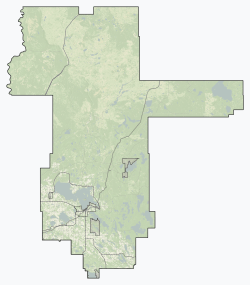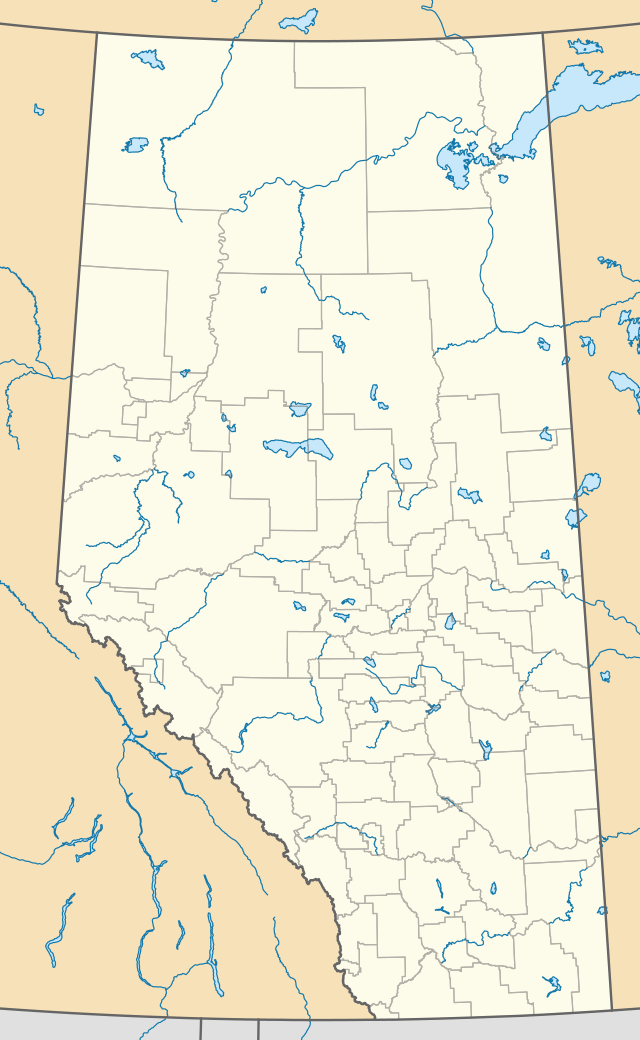Plamondon, Alberta
Plamondon is a hamlet in northern Alberta, Canada within Lac La Biche County.[2] It is located on Highway 858, approximately 3 kilometres (1.9 mi) north of Highway 55, and has an elevation of 555 metres (1,821 ft).
Plamondon | |
|---|---|
 Plamondon  Plamondon | |
| Coordinates: 54.8497°N 112.3419°W | |
| Country | Canada |
| Province | Alberta |
| Census division | No. 12 |
| Municipal district | Lac La Biche County |
| Settled | 1905 |
| Government | |
| • Type | Unincorporated |
| • Mayor | Omer Moghrabi |
| • Governing body | Lac La Biche County Council
|
| Area | |
| • Total | 1.94 km2 (0.75 sq mi) |
| Elevation | 555 m (1,821 ft) |
| Population (2011)[1] | |
| • Total | 345 |
| • Density | 180/km2 (460/sq mi) |
| • Dwellings | 147 |
| Time zone | UTC-7 (MST) |
The hamlet is located in census division No. 12 and in the federal riding of Fort McMurray-Athabasca.
History
The community was founded by Joseph Plamondon in 1908 and settled by primarily French Canadians. Most of the families that eventually settled there came from Provemont, Michigan (now Lake Leelanau in Leelanau County, Michigan) and from French areas of Ontario. This is mentioned in a 1991 interview with Cecelia Bussey: http://leelanauhistory.pastperfectonline.com/archive/027AC0DE-312F-4F0F-85A1-643695582517.
On the outskirts of Plamondon is a community of Old Believers (Old Ritualists), a Traditionalist Russian Orthodox sect whose ancestors broke from the Church after Patriarch Nikon's reforms in 1666. The schism, or Raskol, resulted over reforms in church ritual and translation intended to better align the Russian church with Greek Orthodox practices. The Old Believers that live outside Plamondon are bezpopovtsy, or priestless Old Believers, who believe that apostolic succession ended with Nikon's apostasy and therefore have no clergy and refuse the Eucharist. Most of these families moved to the area in the mid 1970s from Woodburn, Oregon, also home to a large Old Believer community. Many also came from Xinjiang, China, by way of New Zealand, where they fled after the Communist revolutions in Russia and China.
Demographics
As a designated place in the 2016 Census of Population conducted by Statistics Canada, Plamondon recorded a population of 348 living in 136 of its 172 total private dwellings, a change of 0.9% from its 2011 population of 345. With a land area of 1.96 km2 (0.76 sq mi), it had a population density of 177.6/km2 (459.9/sq mi) in 2016.[3]
Lac La Biche County's 2016 municipal census counted a population of 348 in Plamondon,[4] a 1.2% change from the hamlet's 2013 municipal census population of 344.[5]
As a designated place in the 2011 Census, Plamondon had a population of 345 living in 135 of its 147 total dwellings, a 3% change from its 2006 population of 335. With a land area of 1.94 km2 (0.75 sq mi), it had a population density of 177.8/km2 (460.6/sq mi) in 2011.[1]
Economy
The main industries in the region are logging and farming.
Amenities
The community has two schools, Ecole Beausejour and Ecole Plamondon School, which draw students from the entire region. École Plamondon School, offers English, French immersion, and Russian classes. École Beausejour is a francophone school, with instruction surrounding with the francophone culture.
There are two hotels, two banks, post office, indoor hockey arena with artificial ice, a museum, and a rather large church.
The hamlet also holds an annual French hockey tournament called Hockey en Fête. Frontenacs of University of Alberta have won twice. A Canadian Mud Racing Organization (CMRO) event is also held annually at the Plamondon Mud Bog.
See also
References
- "Population and dwelling counts, for Canada, provinces and territories, and designated places, 2011 and 2006 censuses (Alberta)". Statistics Canada. February 8, 2012. Retrieved April 7, 2012.
- "Specialized and Rural Municipalities and Their Communities" (PDF). Alberta Municipal Affairs. April 1, 2010. Archived from the original (PDF) on February 29, 2012. Retrieved June 28, 2010.
- "Population and dwelling counts, for Canada, provinces and territories, and designated places, 2016 and 2011 censuses – 100% data (Alberta)". Statistics Canada. February 8, 2017. Retrieved February 13, 2017.
- "Lac La Biche County 2016 Municipal Census Report". Lac La Biche County. p. 13. Retrieved January 28, 2017.
- "2013 Census Summary". Lac La Biche County. p. 6. Retrieved January 28, 2017.